10 AI employee scheduling tools that save time and reduce costs

Managing employee schedules is a nightmare for most businesses. It's like solving a puzzle that keeps changing shape. Companies stuck with paper schedules and basic spreadsheets face constant headaches, which often mess up the recruitment process when potential hires worry about work-life balance. Shifts get missed.
Teams grow frustrated. Managers waste precious hours fixing problems instead of focusing on finding talent and running the business. That's where AI scheduling tools step in to change everything.
These tools look at your data to predict when you'll need staff, making both scheduling and recruitment easier. They adapt to changes quickly and make better use of everyone's time. Plus, they help attract job seekers who value well-organized workplaces. The end result? Smoother operations, better recruitment, and happier staff.
Let's see how this tech is changing scheduling and what that means for keeping your employees happy.
Overview of AI Employee Scheduling
AI employee scheduling uses smart tech and data to make workforce management better. It cuts down on scheduling problems, saves on labor costs, and makes employees happier.
Definition and Purpose
AI employee scheduling uses computer smarts to automatically create and manage work schedules. It looks at things like when employees can work, what skills they have, and past patterns to build schedules that work well for the business. This makes scheduling much easier, gets rid of human errors, and helps businesses run more smoothly.
Key Features
- Automated Scheduling: Builds schedules based on rules you set, saving hours of work.
- Data-Driven Insights: Uses past data to predict when you'll need more staff, so you're not overstaffed during slow times.
- Employee Preferences: Considers when people want to work, making them happier and less likely to quit.
- Real-Time Adjustments: Quickly updates schedules when someone calls in sick or when things get busy unexpectedly.
- Integration Capabilities: Works with your other HR systems so everything fits together nicely.
Benefits of AI Scheduling Tools
AI scheduling offers major advantages that change how you manage your workforce. It simplifies scheduling, boosts employee morale, and trims costs.
Increased Efficiency
AI takes care of the boring job of making schedules. It looks at employee data and creates optimized schedules in minutes instead of hours. Users notice fewer scheduling conflicts, so operations run more smoothly. Companies that start using AI scheduling often finish projects on time and manage their time better.
Improved Employee Satisfaction
Schedules that fit people's lives make for happier workers. AI checks what employees prefer and when they're free, giving them fairer shifts that match their personal lives. Workers who feel understood put more effort into their jobs and enjoy them more. Happy staff members help build a positive workplace where teamwork grows.
Cost Savings
Smart labor planning means real savings. AI prevents having too many or too few workers on shift, cutting overtime costs and using resources better. Companies can plan their labor costs based on expected customer traffic, which helps boost profits. Switching to AI scheduling often saves lots of money over time, making it worth the investment.
Challenges in Implementing AI Scheduling Tools
Adding AI scheduling to your business comes with some bumps in the road that you'll need to handle for a smooth transition.
Data Privacy Concerns
Keeping employee data safe is a big challenge with AI scheduling. Companies gather sensitive info like availability, preferences, and sometimes performance data. Protecting this info from hackers is really important. Businesses need to follow laws like GDPR and CCPA, which means creating strong data protection rules. Regular security checks and good safety measures help lower the risks of handling personal information.
Resistance to Change
People often don't like new AI scheduling tools. Both staff and managers might prefer doing things the old way and feel uneasy about switching to an AI system. Some worry about losing their jobs or learning new tech. To fix this, companies should offer good training and clear messages showing how AI scheduling can improve work-life balance and make things run better.
Integration with Existing Systems
Getting AI scheduling tools to work with your current HR systems can be tricky. Many businesses use multiple software programs that might not connect well with new AI tools. This can create isolated information, slow things down, and make operations more complex. Companies should carefully look at their current systems and pick AI tools that can easily connect with them. Making sure information flows smoothly between systems helps the whole scheduling process work better.
Popular AI Employee Scheduling Tools
Our Selection Process: We tested tools based on AI features, ease of use, connections with other software, and user reviews. We checked each one for how well it works, focusing on retail, hospitality, and healthcare industries, including both free and paid options.
1. When I Work
Streamlined Scheduling for Modern Teams
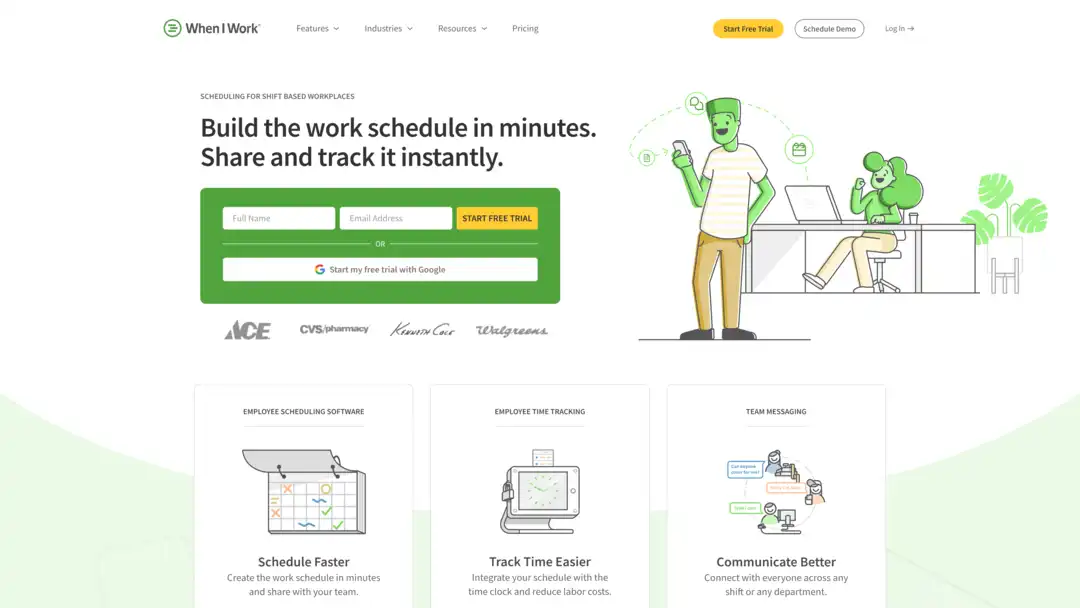
When I Work makes employee scheduling and time tracking simple with easy-to-use desktop and mobile apps that improve communication and accountability.
Key Features:
- Create schedules in minutes and share them instantly.
- Connect time tracking with schedules to reduce labor costs.
- Team messaging for shift coordination.
- Mobile apps for access anywhere.
- Works with payroll and POS systems.
Pricing: Free plan; paid plans from $2/user/month (Premium) and $4/user/month (Business).
Best For: Small to medium-sized businesses in retail, hospitality, and healthcare.
2. Deputy
Smart Scheduling for Hourly Workers
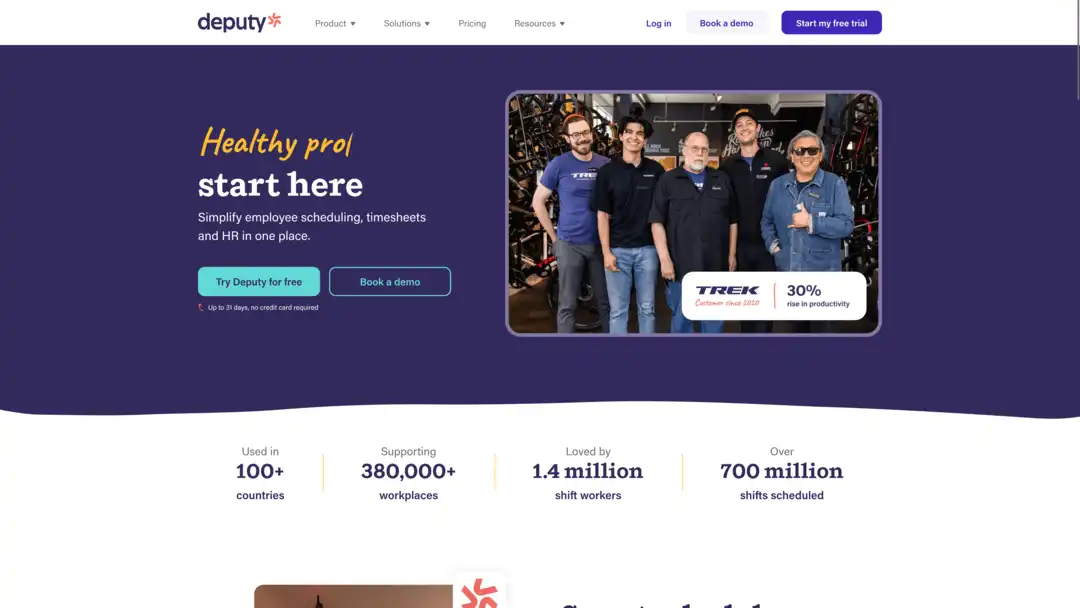
Deputy offers an all-in-one platform for scheduling, HR, and workforce management, using AI to create better shift assignments.
Key Features:
- AI-driven scheduling based on availability and skills.
- Time tracking and compliance with labor laws.
- Group and private messaging.
- Task assignment and tracking.
- Works with Gusto, Shopify, and Square.
Pricing: Free plan; paid plans start at $25/month minimum spend.
Best For: Businesses with hourly workers in retail, hospitality, and healthcare.
3. Shiftboard
Adaptive Scheduling for Complex Needs

Shiftboard uses AI to create worker-friendly schedules, ensuring maximum shift coverage even with last-minute changes.
Key Features:
- AI makes schedules better using past data.
- Real-time updates for absences or overtime.
- Follows labor laws and union rules.
- Team messaging and announcements.
- Reports on labor costs and absent workers.
Pricing: Available upon request.
Best For: Security, healthcare, and hospitality with complex scheduling.
4. Sling
Free Scheduling for Small Businesses
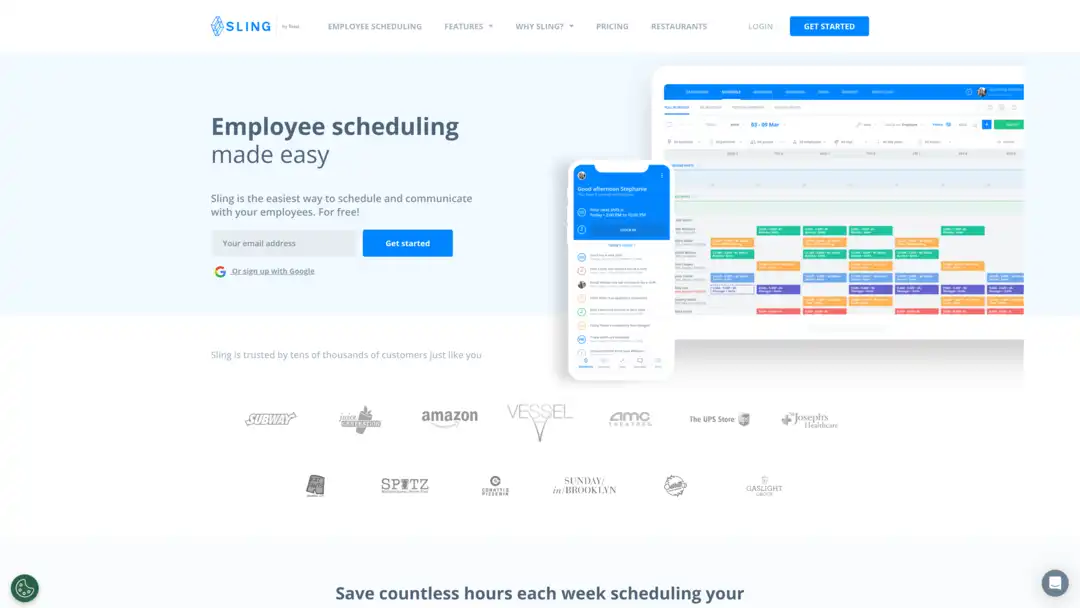
Sling makes scheduling and communication easier, with a free plan that has strong features for small teams.
Key Features:
- Drag-and-drop schedule creation.
- Time tracking and payroll connection.
- Real-time team messaging.
- Shift trade and availability management.
- Labor cost tracking.
Pricing: Free plan; paid plans for advanced features.
Best For: Small businesses in retail, hospitality, and healthcare.
5. Celayix
AI-Driven Workforce Management
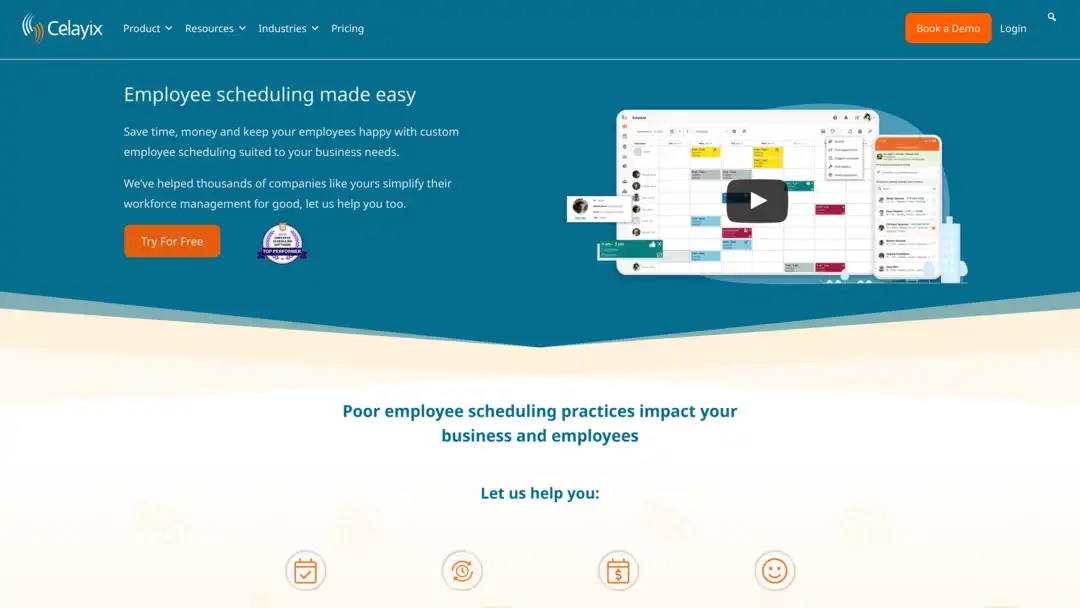
Celayix uses AI to make scheduling, time tracking, and compliance easier for complex industries.
Key Features:
- AI creates ideal schedules using past data.
- Stops time theft and ensures correct payroll.
- Handles last-minute changes easily.
- Follows industry regulations.
- Increases employee retention with fair schedules.
Pricing: Available upon request.
Best For: Security, healthcare, and hospitality.
6. Makeshift
People-First AI Scheduling

Makeshift uses AI to make schedules better, reduce overtime, and make employees happier.
Key Features:
- AI forecasting and automated scheduling.
- Real-time shift changes.
- Team communication tools.
- Time and attendance tracking.
- Works with ADP, SAP, and QuickBooks.
Pricing: Pay-as-you-go; pricing not listed.
Best For: Healthcare, hospitality, security, and retail.
7. Workeen AI
Stress-Free Shift Management
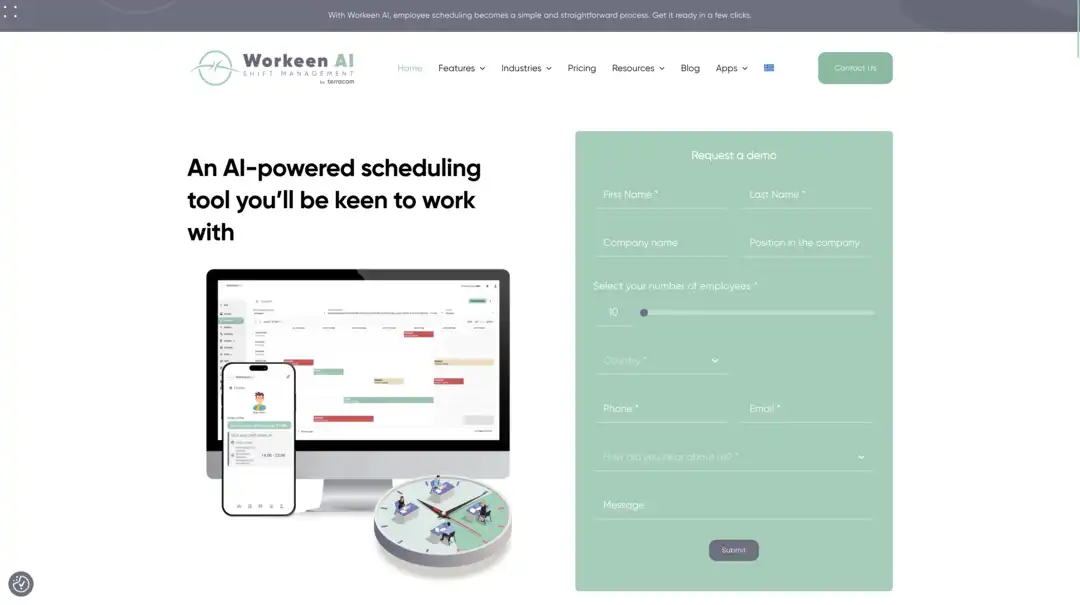
Workeen AI makes rostering simpler with AI-driven scheduling, ensuring efficiency and flexibility.
Key Features:
- Auto-scheduling with rules you set.
- Real-time handling of disruptions.
- Minimal-change rescheduling.
- Team communication tools.
- Scalable and reliable platform.
Pricing: Pay-as-you-go; pricing not listed.
Best For: Healthcare, hospitality, security, and transportation.
8. Rotageek
Optimized Workforce Scheduling
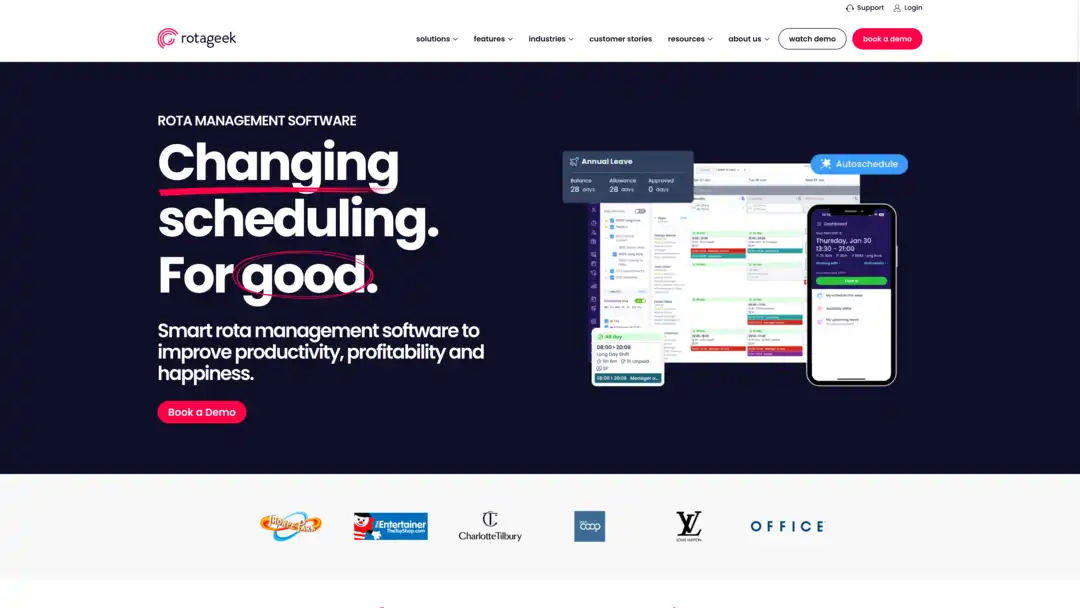
Rotageek uses AI to plan labor efficiently, creating fair and compliant schedules.
Key Features:
- Digital scheduling with preset patterns.
- Auto-scheduling creates millions of combinations.
- Employee app for leave and shift swaps.
- HR and payroll connections.
- Customizable workforce reports.
Pricing: Available upon request.
Best For: Retail, hospitality, entertainment, and healthcare.
9. Connecteam
All-in-One Deskless Team Management
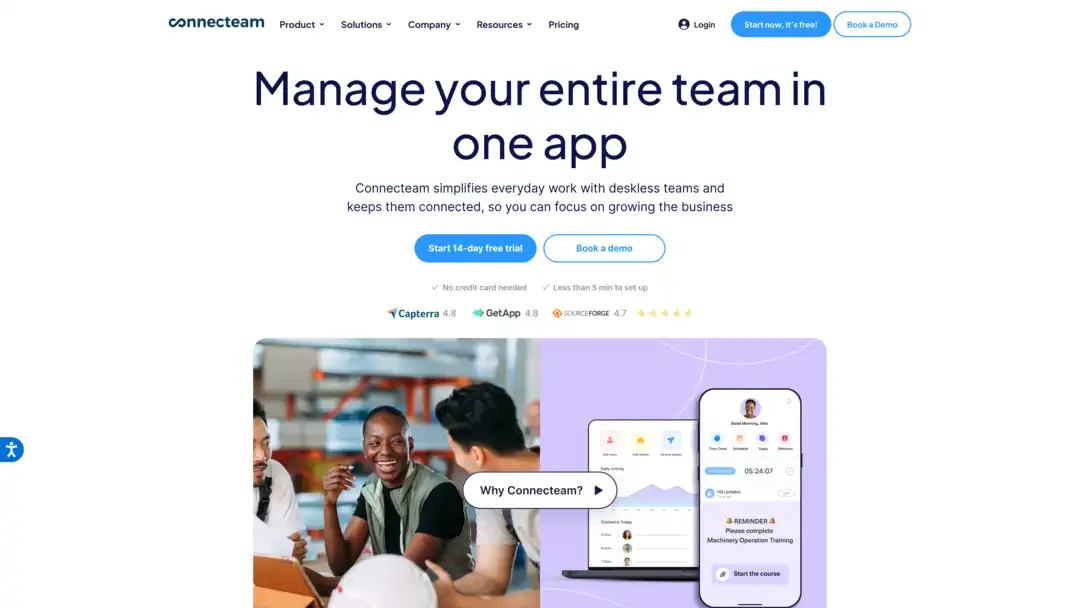
Connecteam is an employee app for scheduling, communication, and training, perfect for teams without desks.
Key Features:
- Schedule creation and task assignment.
- Time tracking and payroll connection.
- In-app communication tools.
- Onboarding and training features.
- Works with Google Calendar and others.
Pricing: Free for up to 10 users; paid plans from $29/month for 30 users.
Best For: Deskless teams in retail, hospitality, and healthcare.
10. 7shifts
Restaurant-Specific Scheduling
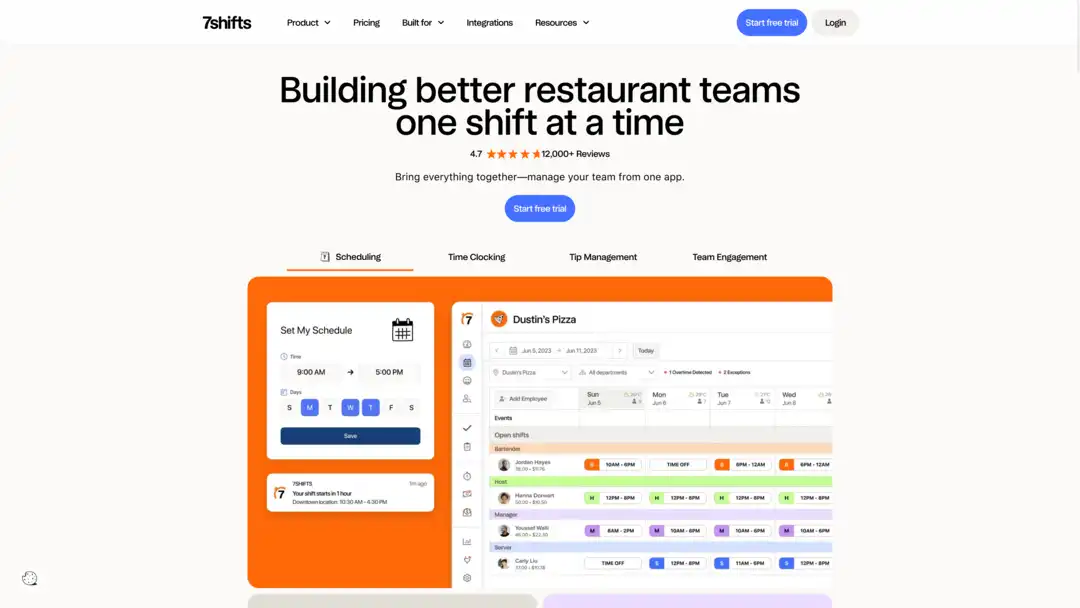
7shifts is a restaurant-focused platform for scheduling, communication, and labor cost management. (7shifts).
Key Features:
- Drag-and-drop shift assignment.
- Conflict alerts for breaks and labor hours.
- POS connection for sales-based scheduling.
- Mobile app for schedule management.
- Real-time team communication.
Pricing: Free plan; paid plans from $19.99/month (The Works) and $39.99/month (Gourmet) per location.
Best For: Restaurants of all sizes.
Tool Comparison
| Tool | AI Features | Pricing |
|---|---|---|
| When I Work | AI schedule optimization | Free; $2-$4/user/month |
| Deputy | AI shift assignment | Free; $25/month minimum |
| Shiftboard | AI adaptive scheduling | Upon request |
| Sling | Schedule automation | Free; paid plans vary |
| Celayix | AI optimal scheduling | Upon request |
| Makeshift | AI forecasting | Pay-as-you-go |
| Workeen AI | AI auto-scheduling | Pay-as-you-go |
| Rotageek | AI schedule combinations | Upon request |
| Connecteam | Task automation | Free; $29/month |
| 7shifts | Sales-based scheduling | Free; $19.99-$39.99/month |
Each tool has strengths, from easy designs to powerful analytics. Companies should think about what they need, like ease of use, connection options, and cost, to find the best match.
User Experiences
Real users share insights about these scheduling tools, focusing on efficiency and ease of use. Many talk about saving time, having fewer scheduling conflicts, and simpler management.
- When I Work: Users love the simple layout and helpful support team, noticing better team communication.
- Deputy: Clients say it's great for following rules, while the mobile app helps staff check schedules easily.
- Shiftboard: Organizations like the customization options, which fit industries with unique needs.
- Celayix: Users say it cuts scheduling time by up to 95%, and many mention the time theft prevention saved them money.
- Sling: Employees like the task management feature that improves accountability and organization.
- Makeshift: Users say the AI forecasting saves hours of planning time, and they like how it balances employee preferences.
- Workeen AI: Transportation companies like the minimal-change rescheduling feature, which keeps things stable even during disruptions.
- Rotageek: Retail managers find it easier to follow labor laws and appreciate how the many schedule combinations find truly best solutions.
- Connecteam: Users with deskless teams love the all-in-one nature, especially the combined scheduling and training features.
- 7shifts: Restaurant owners say connecting with POS systems creates more accurate labor forecasts, saving money during slow periods.
These experiences show how AI scheduling tools can automate complex processes, making workplace dynamics better and everyone happier.
Future Trends in AI Scheduling Tools
Several promising trends are shaping the future of AI scheduling. These advances not only boost efficiency but also change how we think about managing workers across industries.
Advances in Technology
New tech like machine learning and natural language processing are pushing AI scheduling forward. Algorithms are getting smarter, making better staffing predictions based on real-time data. Mobile apps are evolving too, giving employees easier ways to manage schedules. Connection with IoT devices and cloud computing helps collect and analyze data better, providing deeper insights into workforce patterns. Predictive analytics keeps improving, making it easier for businesses to see changes coming and adjust schedules quickly.
Impact on Workforce Management
AI scheduling is really changing workforce management. Businesses using these systems get better labor allocation, with ideal staffing levels and lower costs. More personalization lets employees have more say about their preferences, leading to higher job satisfaction and less turnover. The ability to adapt to real-time changes, like sudden absences or increased demand, helps businesses stay nimble. The future of workforce management will likely have more flexibility and more engaged employees, all driven by data and AI capabilities.
Key Takeaways
AI employee scheduling is changing the game for businesses wanting better efficiency and happier employees. By using smart algorithms and data analysis, these tools create better schedules that meet both business needs and what employees want.
This tech not only reduces conflicts but also creates a more engaged team. While challenges like data privacy and resistance to change exist, with proper training and clear communication these obstacles can be overcome.
Looking at the future of AI scheduling tools, we're excited about even better integration and adaptability in workforce management. Using these tools can create a more flexible and productive workplace that benefits everyone involved.